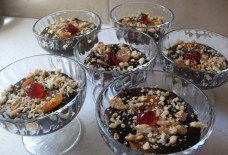Arabic Chat Alphabet- Writing Arabic but in English
By: Noura Abou Hamze/Arab America Contributing Writer
The Arabic language is widely spoken all over the world and is the official language in twenty-three Arab countries.
Have you ever heard about a special form of writing Arabic, called the Arabic Chat Alphabet?
The Arabic chat alphabet , alternatively the Franco-Arabic alphabet, or ‘Arabizi’ , is an alternative to the standard written Arabic that uses the Latin script. Arabglish, also known as “Arabizi”, Arabish (Arabic plus English) or Arabglizi is the informal Arabic chat alphabet which became a popular phenomenon among younger generations with the introduction of technology between the mid-1990s to early 2000s.
Many young Arabs who study in private schools that use English as a language of instruction, prefer Arabizi in texting and conversations on their smart phones and social media because they find typing in English easier than in Arabic. For this reason there is a pronounced fear that Arabizi will weaken the Arabic language, or even replace it, and threatens Arab identity, as well as, the Arab value system.
The Roman numerals are used to symbolize the Arabic letters which don’t exist, or rather, the ones that have no phonetic equivalent in English. The Arabic chat alphabet uses the Latin script to spell out words phonetically, with the special addition of 7 numbers, which represent those Arabic characters not found in English. The above picture represents those letters, for example the letter 3 represents letter ayn “ع” and letter 7 represents letter H which is “ح”. For instance تحكي عربي؟, or “do you speak Arabic?” becomes “ta7ki 3arabi?”.
In Arabizi, there is no indication of what the vowels are without context. For instance, there is no distinction between letters e, i, long i and long e. For example, “kerse” can be interpreted as either ‘catastrophe’ “كارثة” or ‘chair’ “كرسي”. Also, long a vowels tend to not be represented at all, with words like “khaf” that can be interpreted as ‘he got scared’ <خاف> with a long a, or ‘lessened’ <خَف> with a short a. Generally, Arabizi vowels lack much-needed standardization to be considered concise and accurate orthography.
For example, letter 7 = ح (Haa) which is a stronger “Hh” sound than the ه (haa). In formal Arabic writing, the comment would have said, حلوة كتير which translates to ” very nice”. 5 = خ (khaa) is most commonly used in the Arab World for the word ‘ Khalas’ translating to enough/ stop and is written ‘5alas’. Finally, the 2 = أ & ء (aalif & hamza), or the أ, is accompanied by a ء, there’s a subtle glottal stop in pronunciation. The 2 in Arabizi emphasizes that. Imagine you’re hungry and want to grab a bite of food with friends. You can text them, “2ana jo3an” (أنا جعان) which means ‘ i am hungry’.
Check out Arab America’s blog here!








